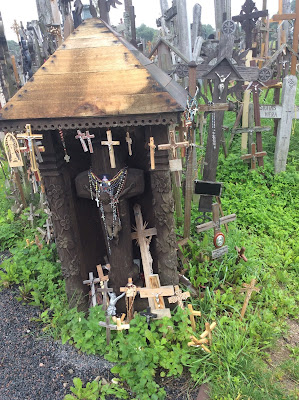Thousands upon Thousands
In Lithuania, on a hill that has been a pilgrimage site for centuries, is a densely-packed collection of scores of thousands of crosses in all sizes and forms. The crosses were first set there after a failed rebellion against the Russians in the 1830's. The site became a symbol of Lithuanian independence, and was bulldozed twice by the Soviets during the occupation. But now it is a much visited pilgrimage and tourist spot.
 |
| This is the pathway leading to the hill seen in the background. |
 |
| By the parking area was this stork nest. Storks are considered bringers of good fortune. |
 |
| Several storks were going about their business, unmindful of the humanity swirling around them. |
 |
| Storks mate for life and return to the same nesting site, when they can. |
 |
| This pavilion by the cross hill was erected for a papal visit a few years ago. |
 |
| An edge below the hill for some of the overflow of crosses. |
 |
| All crosses placed today are supposed to be of wood, but some older crosses are of many other materials. |
 |
| This little cluster had over thirty crosses by this one shrine. |
 |
| Many rosaries and plaques and prayer requests were placed among the crosses. |
 |
| Some crosses were beautifully carved or ornamented. |
 |
| Some crosses were plain and rugged. |
 |
| A narrow stairway led up the hill, with crosses crowding both sides and little paths wandering off to the sides in the jungle of crosses. |
 |
| We thought this weary Christ figure quite striking, weighted down by innumerable crosses. |
 |
| A side path through the forest of crosses |
 |
| Someone placing her own cross |
 |
| Crosses for children |
 |
| Recent crosses |
 |
| Old weathered crosses |
 |
| Adornments on the crosses |
 |
| Rosaries on crosses on crosses on crosses |
 |
| As the stars in the heavens for multitude |
 |
| new crosses by old crosses |
 |
| Someone needed a church with his cross. |
 |
| A new carved piece at the base of the hill - probably The Stations of the Cross |
 |
| A small area of the outer end of one arm of one cross |
 |
| On the path leading away from the hill was this cross for a sports team. |
We noticed the Baltics people take their faith seriously. They have had a tremendously difficult history, which could induce a people to look heavenward.
Now who can count the crosses shown here? Yes, impossible, so how about the word cross(es) in this post?



























This was a fascinating post (but sorry, I'm not going to count anything, I still have four dozen apple turnovers to make). I am assuming the Lithuanians are most Catholic? I remember the Lutheran church you visited. Did the Reformation have much impact? I have to say I feel like all the crosses, by the end, removed the significance and it just seemed to be about the numbers (like the padlocks on the Parisian bridges). (Am I being cynical?) But still, no such thing in America. People have taken to putting crosses along the road where fatal accidents have occurred. One cross for each victim. There are two such memorials just steps from my house.
ReplyDeleteThe Lithuanians are often Catholic, but many are Orthodox (from Russian resettlements of populations), and quite a percentage are Lutheran. One will see Lutheran churches in most towns.
ReplyDeleteWhen one is at the site of all the crosses, while they are a mass together, they are actually a striking testimony of the spirit of the people who would not give up their faith and continued to fight for their independence to practice that faith. Now, of course, many tourists add crosses for who knows what reasons, but the site is still Lithuanian in spirit, I thought. Most of the old crosses and many of the newer ones have heartfelt work, ornaments, messages, and money put into them before they are placed, so it is not about the numbers.
As to placing crosses at the site of a death, that is a very old and still applied custom all over Europe. Just up the road at the Tierpark sign is a small wooden cross placed by the family of the young man on a motorcycle who was killed there a few years ago. The Tierpark management might not like to have to mow around that cross, but no one would dare to remove it; it is a sacred custom that is of great significance to the bereaved family. You see such crosses all over, often richly decorated with flowers year after year. Probably you have Europeans translated there that brought their customs.
Best wishes with turnovers.
It wasn't just Lithuanians and tourists who planted crosses, either. There were crosses donated by Catholics from a NATO training mission several years ago,two large stone crosses put up by Armenians as a reminder of their genocide by the Turks (yeah, looks like Turks have nothing to say in Baltics. Man is that nice...), and a cross by an American family with an American-name (possibly originally Baltic German). Especially the larger crosses speak for people who take their faith very seriously.
ReplyDelete